Innovation and Commercialisation: Business Report and Analysis
VerifiedAdded on 2023/01/13
|25
|6804
|21
Report
AI Summary
This report delves into the critical aspects of innovation and commercialization within a business context, using Bigbelly smart solutions as a case study. It begins by differentiating between innovation and invention, particularly focusing on the challenges faced by small businesses and the importance of converting inventions into marketable innovations. The report then explores innovation management, including the creation of a supportive organizational structure and culture, and the development of innovation vision, leadership, and networks. Different types of innovation are examined, such as incremental and disruptive innovation, along with the 4Ps framework and frugal innovation. The process of commercializing innovation is outlined, followed by an evaluation of various methods for protecting intellectual property rights. The report concludes by emphasizing the interconnectedness of innovation and commercialization for achieving social benefits and driving business success.
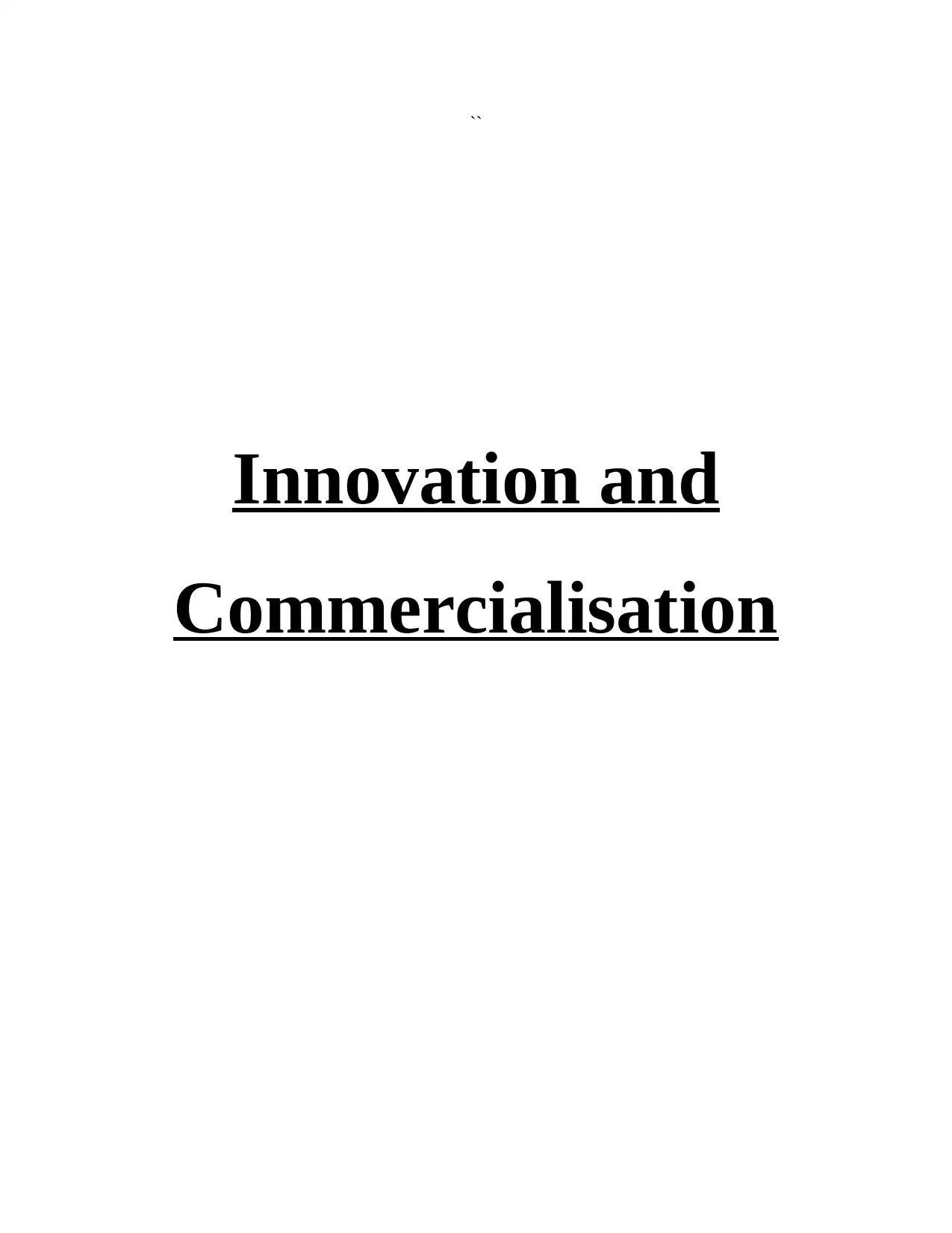
``
Innovation and
Commercialisation
Innovation and
Commercialisation
Paraphrase This Document
Need a fresh take? Get an instant paraphrase of this document with our AI Paraphraser
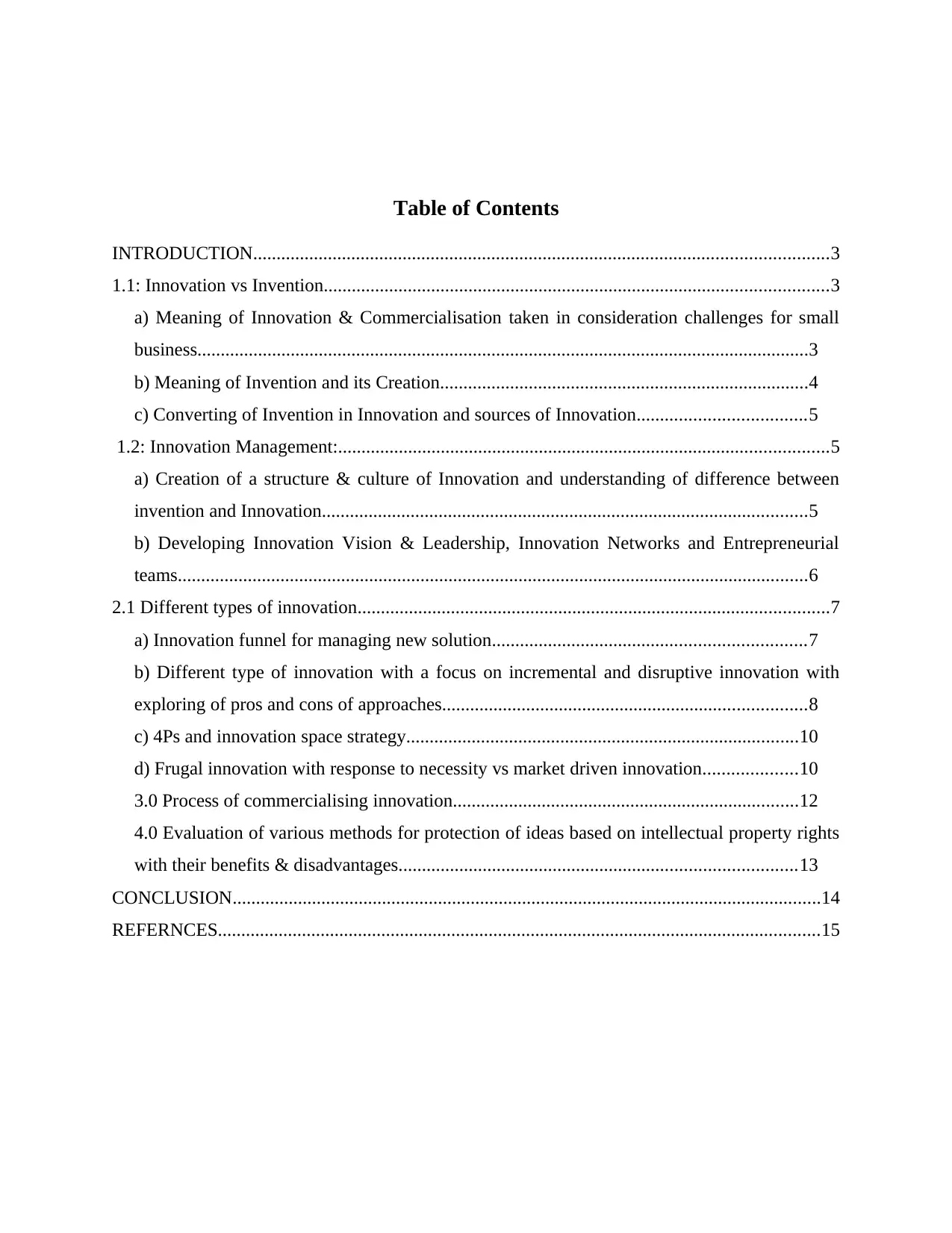
Table of Contents
INTRODUCTION...........................................................................................................................3
1.1: Innovation vs Invention............................................................................................................3
a) Meaning of Innovation & Commercialisation taken in consideration challenges for small
business...................................................................................................................................3
b) Meaning of Invention and its Creation...............................................................................4
c) Converting of Invention in Innovation and sources of Innovation....................................5
1.2: Innovation Management:.........................................................................................................5
a) Creation of a structure & culture of Innovation and understanding of difference between
invention and Innovation........................................................................................................5
b) Developing Innovation Vision & Leadership, Innovation Networks and Entrepreneurial
teams.......................................................................................................................................6
2.1 Different types of innovation.....................................................................................................7
a) Innovation funnel for managing new solution...................................................................7
b) Different type of innovation with a focus on incremental and disruptive innovation with
exploring of pros and cons of approaches..............................................................................8
c) 4Ps and innovation space strategy....................................................................................10
d) Frugal innovation with response to necessity vs market driven innovation....................10
3.0 Process of commercialising innovation..........................................................................12
4.0 Evaluation of various methods for protection of ideas based on intellectual property rights
with their benefits & disadvantages.....................................................................................13
CONCLUSION..............................................................................................................................14
REFERNCES.................................................................................................................................15
INTRODUCTION...........................................................................................................................3
1.1: Innovation vs Invention............................................................................................................3
a) Meaning of Innovation & Commercialisation taken in consideration challenges for small
business...................................................................................................................................3
b) Meaning of Invention and its Creation...............................................................................4
c) Converting of Invention in Innovation and sources of Innovation....................................5
1.2: Innovation Management:.........................................................................................................5
a) Creation of a structure & culture of Innovation and understanding of difference between
invention and Innovation........................................................................................................5
b) Developing Innovation Vision & Leadership, Innovation Networks and Entrepreneurial
teams.......................................................................................................................................6
2.1 Different types of innovation.....................................................................................................7
a) Innovation funnel for managing new solution...................................................................7
b) Different type of innovation with a focus on incremental and disruptive innovation with
exploring of pros and cons of approaches..............................................................................8
c) 4Ps and innovation space strategy....................................................................................10
d) Frugal innovation with response to necessity vs market driven innovation....................10
3.0 Process of commercialising innovation..........................................................................12
4.0 Evaluation of various methods for protection of ideas based on intellectual property rights
with their benefits & disadvantages.....................................................................................13
CONCLUSION..............................................................................................................................14
REFERNCES.................................................................................................................................15

⊘ This is a preview!⊘
Do you want full access?
Subscribe today to unlock all pages.

Trusted by 1+ million students worldwide
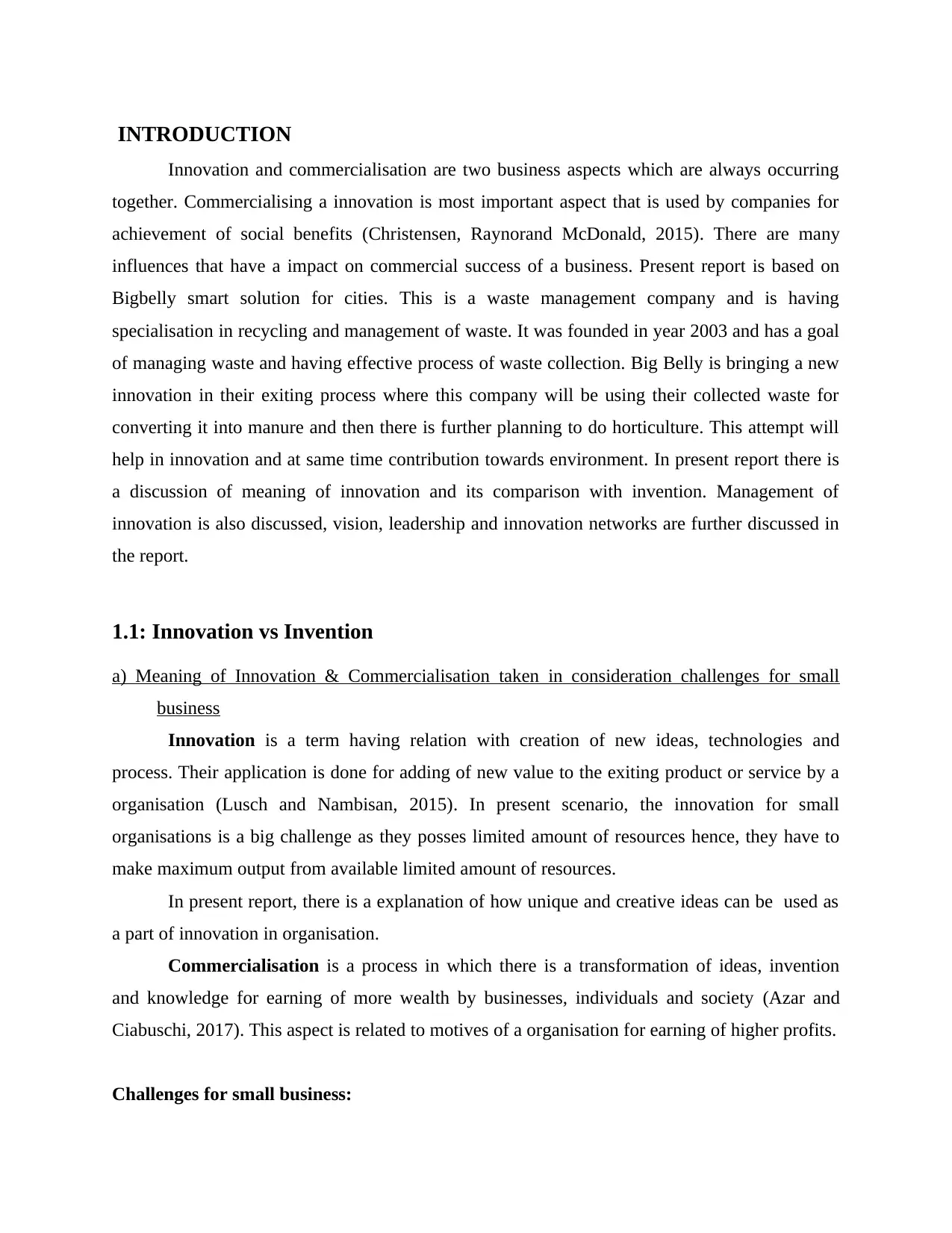
INTRODUCTION
Innovation and commercialisation are two business aspects which are always occurring
together. Commercialising a innovation is most important aspect that is used by companies for
achievement of social benefits (Christensen, Raynorand McDonald, 2015). There are many
influences that have a impact on commercial success of a business. Present report is based on
Bigbelly smart solution for cities. This is a waste management company and is having
specialisation in recycling and management of waste. It was founded in year 2003 and has a goal
of managing waste and having effective process of waste collection. Big Belly is bringing a new
innovation in their exiting process where this company will be using their collected waste for
converting it into manure and then there is further planning to do horticulture. This attempt will
help in innovation and at same time contribution towards environment. In present report there is
a discussion of meaning of innovation and its comparison with invention. Management of
innovation is also discussed, vision, leadership and innovation networks are further discussed in
the report.
1.1: Innovation vs Invention
a) Meaning of Innovation & Commercialisation taken in consideration challenges for small
business
Innovation is a term having relation with creation of new ideas, technologies and
process. Their application is done for adding of new value to the exiting product or service by a
organisation (Lusch and Nambisan, 2015). In present scenario, the innovation for small
organisations is a big challenge as they posses limited amount of resources hence, they have to
make maximum output from available limited amount of resources.
In present report, there is a explanation of how unique and creative ideas can be used as
a part of innovation in organisation.
Commercialisation is a process in which there is a transformation of ideas, invention
and knowledge for earning of more wealth by businesses, individuals and society (Azar and
Ciabuschi, 2017). This aspect is related to motives of a organisation for earning of higher profits.
Challenges for small business:
Innovation and commercialisation are two business aspects which are always occurring
together. Commercialising a innovation is most important aspect that is used by companies for
achievement of social benefits (Christensen, Raynorand McDonald, 2015). There are many
influences that have a impact on commercial success of a business. Present report is based on
Bigbelly smart solution for cities. This is a waste management company and is having
specialisation in recycling and management of waste. It was founded in year 2003 and has a goal
of managing waste and having effective process of waste collection. Big Belly is bringing a new
innovation in their exiting process where this company will be using their collected waste for
converting it into manure and then there is further planning to do horticulture. This attempt will
help in innovation and at same time contribution towards environment. In present report there is
a discussion of meaning of innovation and its comparison with invention. Management of
innovation is also discussed, vision, leadership and innovation networks are further discussed in
the report.
1.1: Innovation vs Invention
a) Meaning of Innovation & Commercialisation taken in consideration challenges for small
business
Innovation is a term having relation with creation of new ideas, technologies and
process. Their application is done for adding of new value to the exiting product or service by a
organisation (Lusch and Nambisan, 2015). In present scenario, the innovation for small
organisations is a big challenge as they posses limited amount of resources hence, they have to
make maximum output from available limited amount of resources.
In present report, there is a explanation of how unique and creative ideas can be used as
a part of innovation in organisation.
Commercialisation is a process in which there is a transformation of ideas, invention
and knowledge for earning of more wealth by businesses, individuals and society (Azar and
Ciabuschi, 2017). This aspect is related to motives of a organisation for earning of higher profits.
Challenges for small business:
Paraphrase This Document
Need a fresh take? Get an instant paraphrase of this document with our AI Paraphraser
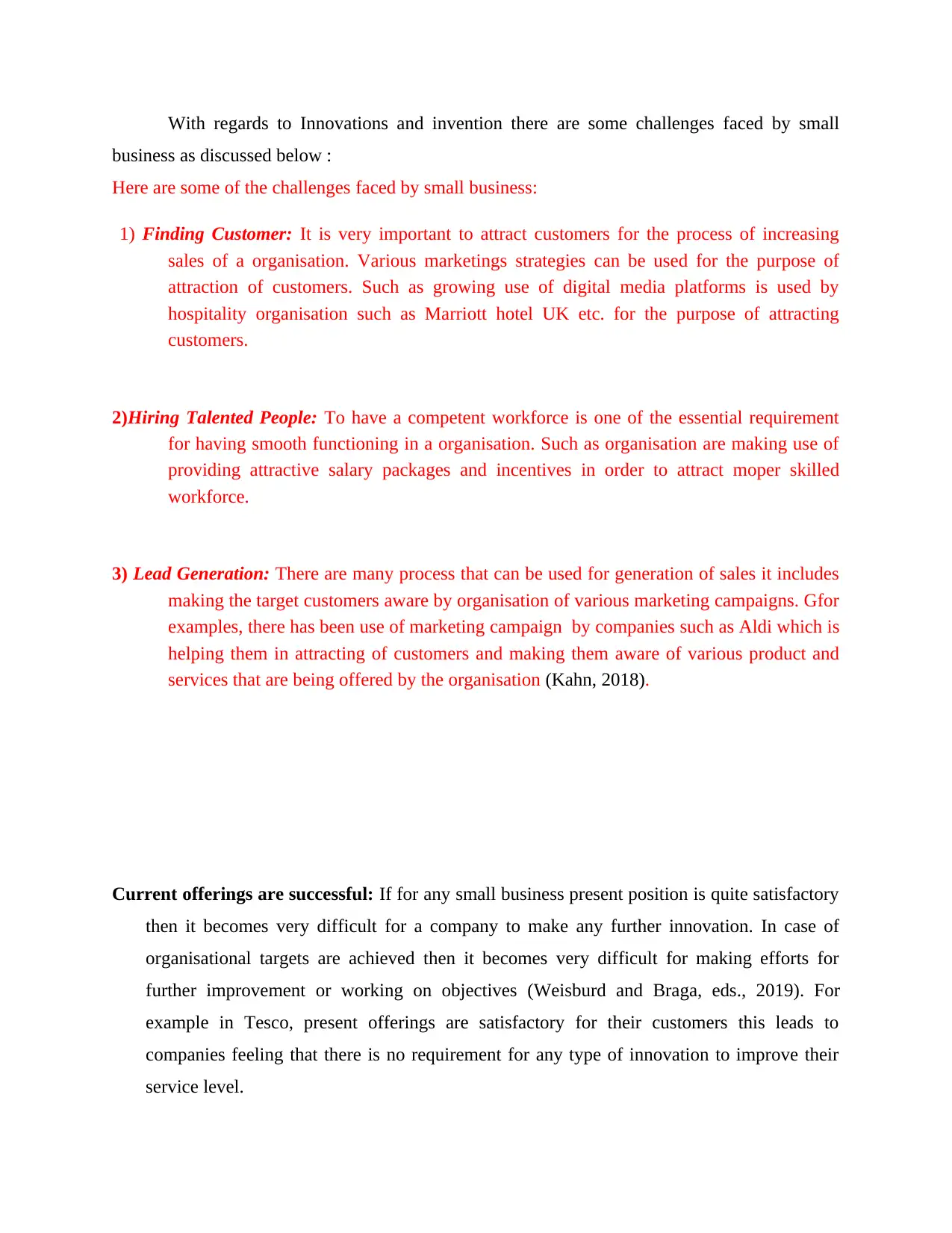
With regards to Innovations and invention there are some challenges faced by small
business as discussed below :
Here are some of the challenges faced by small business:
1) Finding Customer: It is very important to attract customers for the process of increasing
sales of a organisation. Various marketings strategies can be used for the purpose of
attraction of customers. Such as growing use of digital media platforms is used by
hospitality organisation such as Marriott hotel UK etc. for the purpose of attracting
customers.
2)Hiring Talented People: To have a competent workforce is one of the essential requirement
for having smooth functioning in a organisation. Such as organisation are making use of
providing attractive salary packages and incentives in order to attract moper skilled
workforce.
3) Lead Generation: There are many process that can be used for generation of sales it includes
making the target customers aware by organisation of various marketing campaigns. Gfor
examples, there has been use of marketing campaign by companies such as Aldi which is
helping them in attracting of customers and making them aware of various product and
services that are being offered by the organisation (Kahn, 2018).
Current offerings are successful: If for any small business present position is quite satisfactory
then it becomes very difficult for a company to make any further innovation. In case of
organisational targets are achieved then it becomes very difficult for making efforts for
further improvement or working on objectives (Weisburd and Braga, eds., 2019). For
example in Tesco, present offerings are satisfactory for their customers this leads to
companies feeling that there is no requirement for any type of innovation to improve their
service level.
business as discussed below :
Here are some of the challenges faced by small business:
1) Finding Customer: It is very important to attract customers for the process of increasing
sales of a organisation. Various marketings strategies can be used for the purpose of
attraction of customers. Such as growing use of digital media platforms is used by
hospitality organisation such as Marriott hotel UK etc. for the purpose of attracting
customers.
2)Hiring Talented People: To have a competent workforce is one of the essential requirement
for having smooth functioning in a organisation. Such as organisation are making use of
providing attractive salary packages and incentives in order to attract moper skilled
workforce.
3) Lead Generation: There are many process that can be used for generation of sales it includes
making the target customers aware by organisation of various marketing campaigns. Gfor
examples, there has been use of marketing campaign by companies such as Aldi which is
helping them in attracting of customers and making them aware of various product and
services that are being offered by the organisation (Kahn, 2018).
Current offerings are successful: If for any small business present position is quite satisfactory
then it becomes very difficult for a company to make any further innovation. In case of
organisational targets are achieved then it becomes very difficult for making efforts for
further improvement or working on objectives (Weisburd and Braga, eds., 2019). For
example in Tesco, present offerings are satisfactory for their customers this leads to
companies feeling that there is no requirement for any type of innovation to improve their
service level.
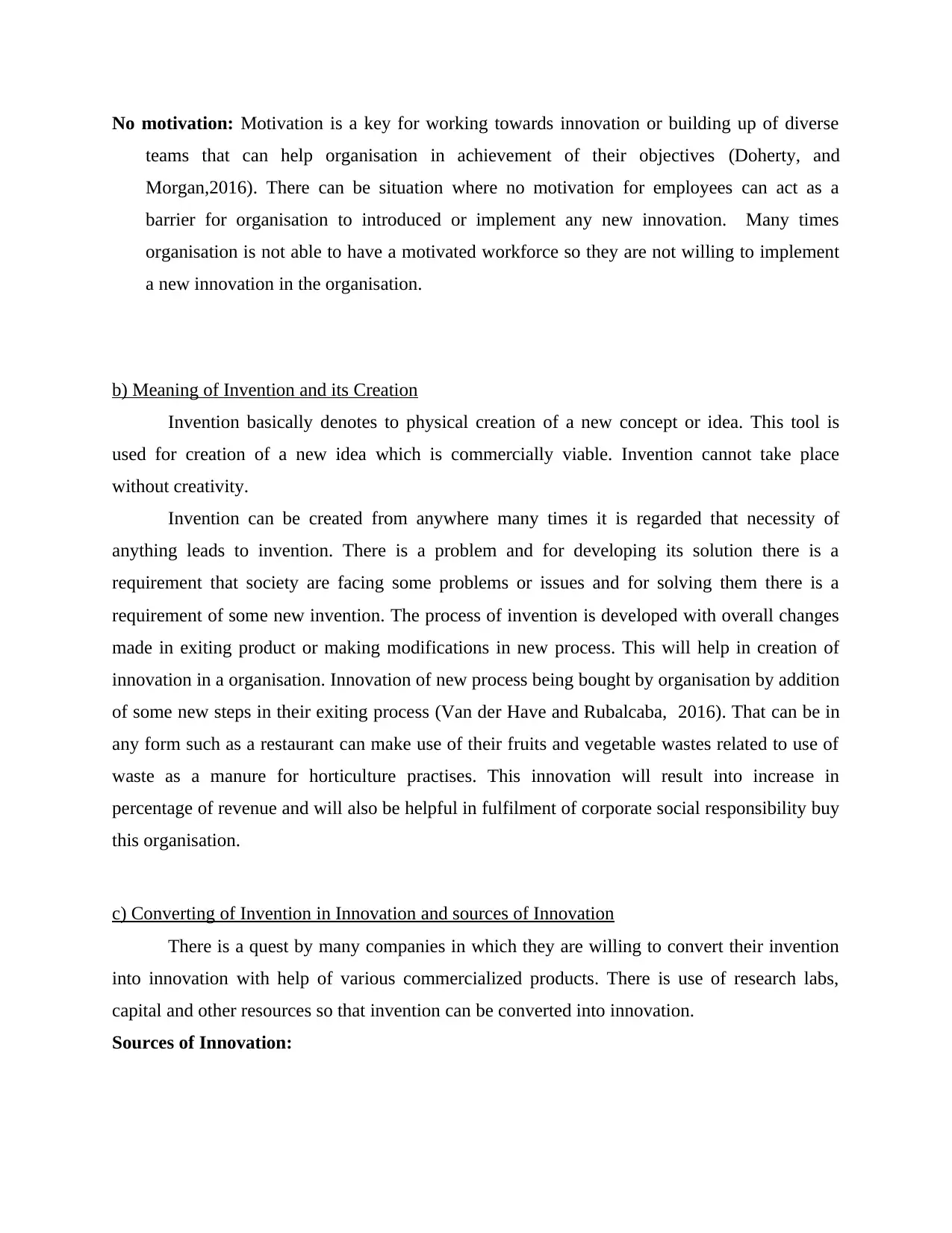
No motivation: Motivation is a key for working towards innovation or building up of diverse
teams that can help organisation in achievement of their objectives (Doherty, and
Morgan,2016). There can be situation where no motivation for employees can act as a
barrier for organisation to introduced or implement any new innovation. Many times
organisation is not able to have a motivated workforce so they are not willing to implement
a new innovation in the organisation.
b) Meaning of Invention and its Creation
Invention basically denotes to physical creation of a new concept or idea. This tool is
used for creation of a new idea which is commercially viable. Invention cannot take place
without creativity.
Invention can be created from anywhere many times it is regarded that necessity of
anything leads to invention. There is a problem and for developing its solution there is a
requirement that society are facing some problems or issues and for solving them there is a
requirement of some new invention. The process of invention is developed with overall changes
made in exiting product or making modifications in new process. This will help in creation of
innovation in a organisation. Innovation of new process being bought by organisation by addition
of some new steps in their exiting process (Van der Have and Rubalcaba, 2016). That can be in
any form such as a restaurant can make use of their fruits and vegetable wastes related to use of
waste as a manure for horticulture practises. This innovation will result into increase in
percentage of revenue and will also be helpful in fulfilment of corporate social responsibility buy
this organisation.
c) Converting of Invention in Innovation and sources of Innovation
There is a quest by many companies in which they are willing to convert their invention
into innovation with help of various commercialized products. There is use of research labs,
capital and other resources so that invention can be converted into innovation.
Sources of Innovation:
teams that can help organisation in achievement of their objectives (Doherty, and
Morgan,2016). There can be situation where no motivation for employees can act as a
barrier for organisation to introduced or implement any new innovation. Many times
organisation is not able to have a motivated workforce so they are not willing to implement
a new innovation in the organisation.
b) Meaning of Invention and its Creation
Invention basically denotes to physical creation of a new concept or idea. This tool is
used for creation of a new idea which is commercially viable. Invention cannot take place
without creativity.
Invention can be created from anywhere many times it is regarded that necessity of
anything leads to invention. There is a problem and for developing its solution there is a
requirement that society are facing some problems or issues and for solving them there is a
requirement of some new invention. The process of invention is developed with overall changes
made in exiting product or making modifications in new process. This will help in creation of
innovation in a organisation. Innovation of new process being bought by organisation by addition
of some new steps in their exiting process (Van der Have and Rubalcaba, 2016). That can be in
any form such as a restaurant can make use of their fruits and vegetable wastes related to use of
waste as a manure for horticulture practises. This innovation will result into increase in
percentage of revenue and will also be helpful in fulfilment of corporate social responsibility buy
this organisation.
c) Converting of Invention in Innovation and sources of Innovation
There is a quest by many companies in which they are willing to convert their invention
into innovation with help of various commercialized products. There is use of research labs,
capital and other resources so that invention can be converted into innovation.
Sources of Innovation:
⊘ This is a preview!⊘
Do you want full access?
Subscribe today to unlock all pages.

Trusted by 1+ million students worldwide
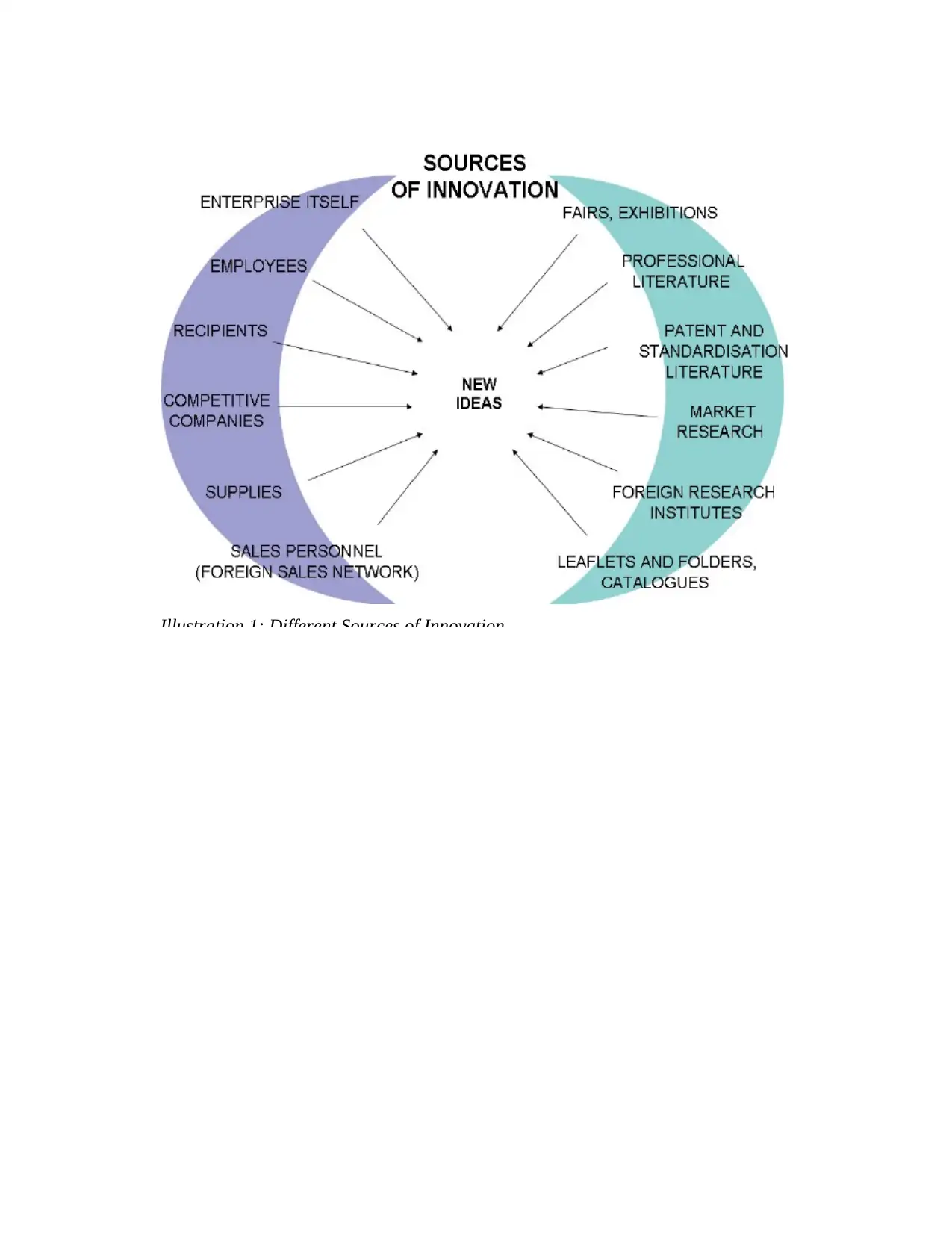
Illustration 1: Different Sources of Innovation
Paraphrase This Document
Need a fresh take? Get an instant paraphrase of this document with our AI Paraphraser
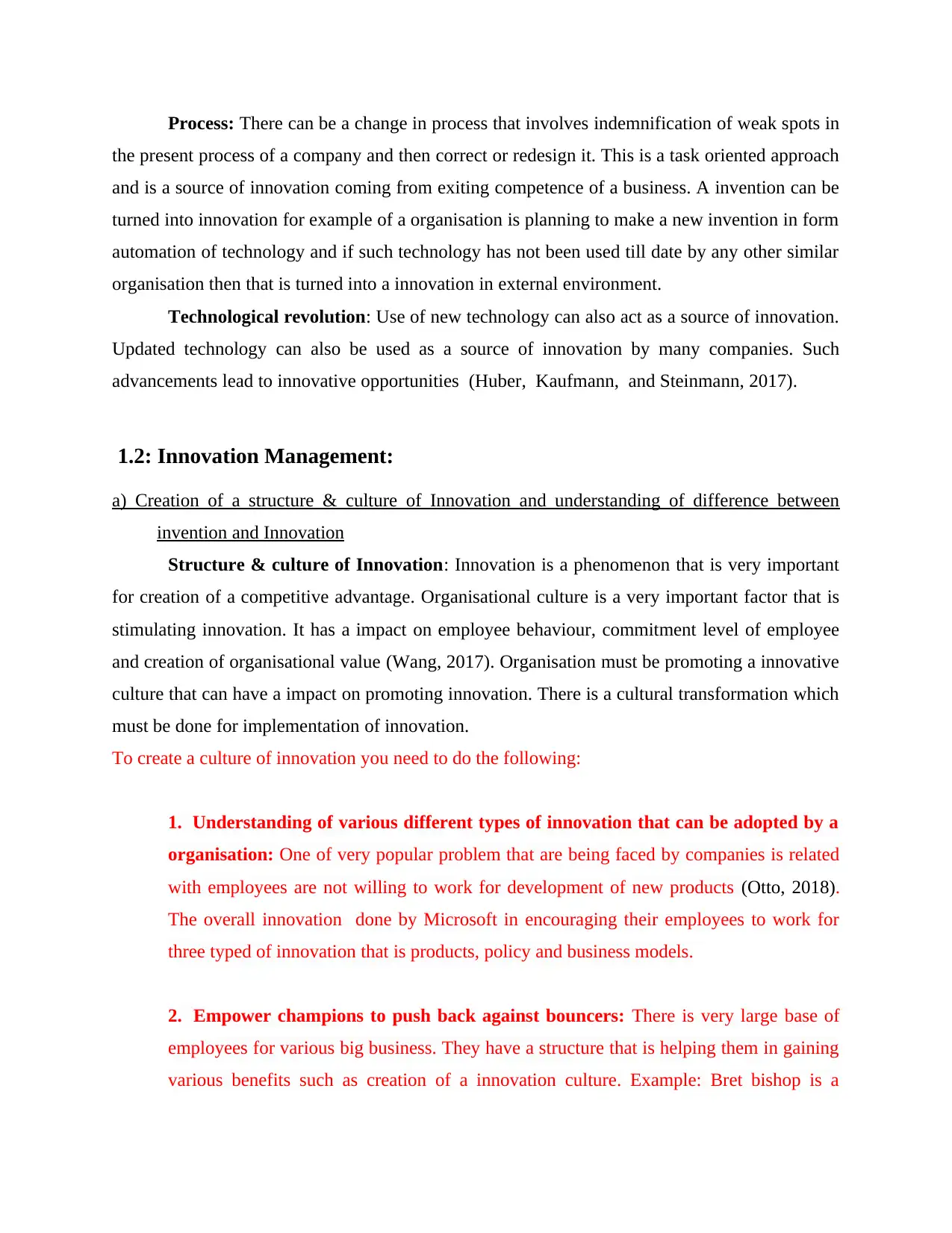
Process: There can be a change in process that involves indemnification of weak spots in
the present process of a company and then correct or redesign it. This is a task oriented approach
and is a source of innovation coming from exiting competence of a business. A invention can be
turned into innovation for example of a organisation is planning to make a new invention in form
automation of technology and if such technology has not been used till date by any other similar
organisation then that is turned into a innovation in external environment.
Technological revolution: Use of new technology can also act as a source of innovation.
Updated technology can also be used as a source of innovation by many companies. Such
advancements lead to innovative opportunities (Huber, Kaufmann, and Steinmann, 2017).
1.2: Innovation Management:
a) Creation of a structure & culture of Innovation and understanding of difference between
invention and Innovation
Structure & culture of Innovation: Innovation is a phenomenon that is very important
for creation of a competitive advantage. Organisational culture is a very important factor that is
stimulating innovation. It has a impact on employee behaviour, commitment level of employee
and creation of organisational value (Wang, 2017). Organisation must be promoting a innovative
culture that can have a impact on promoting innovation. There is a cultural transformation which
must be done for implementation of innovation.
To create a culture of innovation you need to do the following:
1. Understanding of various different types of innovation that can be adopted by a
organisation: One of very popular problem that are being faced by companies is related
with employees are not willing to work for development of new products (Otto, 2018).
The overall innovation done by Microsoft in encouraging their employees to work for
three typed of innovation that is products, policy and business models.
2. Empower champions to push back against bouncers: There is very large base of
employees for various big business. They have a structure that is helping them in gaining
various benefits such as creation of a innovation culture. Example: Bret bishop is a
the present process of a company and then correct or redesign it. This is a task oriented approach
and is a source of innovation coming from exiting competence of a business. A invention can be
turned into innovation for example of a organisation is planning to make a new invention in form
automation of technology and if such technology has not been used till date by any other similar
organisation then that is turned into a innovation in external environment.
Technological revolution: Use of new technology can also act as a source of innovation.
Updated technology can also be used as a source of innovation by many companies. Such
advancements lead to innovative opportunities (Huber, Kaufmann, and Steinmann, 2017).
1.2: Innovation Management:
a) Creation of a structure & culture of Innovation and understanding of difference between
invention and Innovation
Structure & culture of Innovation: Innovation is a phenomenon that is very important
for creation of a competitive advantage. Organisational culture is a very important factor that is
stimulating innovation. It has a impact on employee behaviour, commitment level of employee
and creation of organisational value (Wang, 2017). Organisation must be promoting a innovative
culture that can have a impact on promoting innovation. There is a cultural transformation which
must be done for implementation of innovation.
To create a culture of innovation you need to do the following:
1. Understanding of various different types of innovation that can be adopted by a
organisation: One of very popular problem that are being faced by companies is related
with employees are not willing to work for development of new products (Otto, 2018).
The overall innovation done by Microsoft in encouraging their employees to work for
three typed of innovation that is products, policy and business models.
2. Empower champions to push back against bouncers: There is very large base of
employees for various big business. They have a structure that is helping them in gaining
various benefits such as creation of a innovation culture. Example: Bret bishop is a
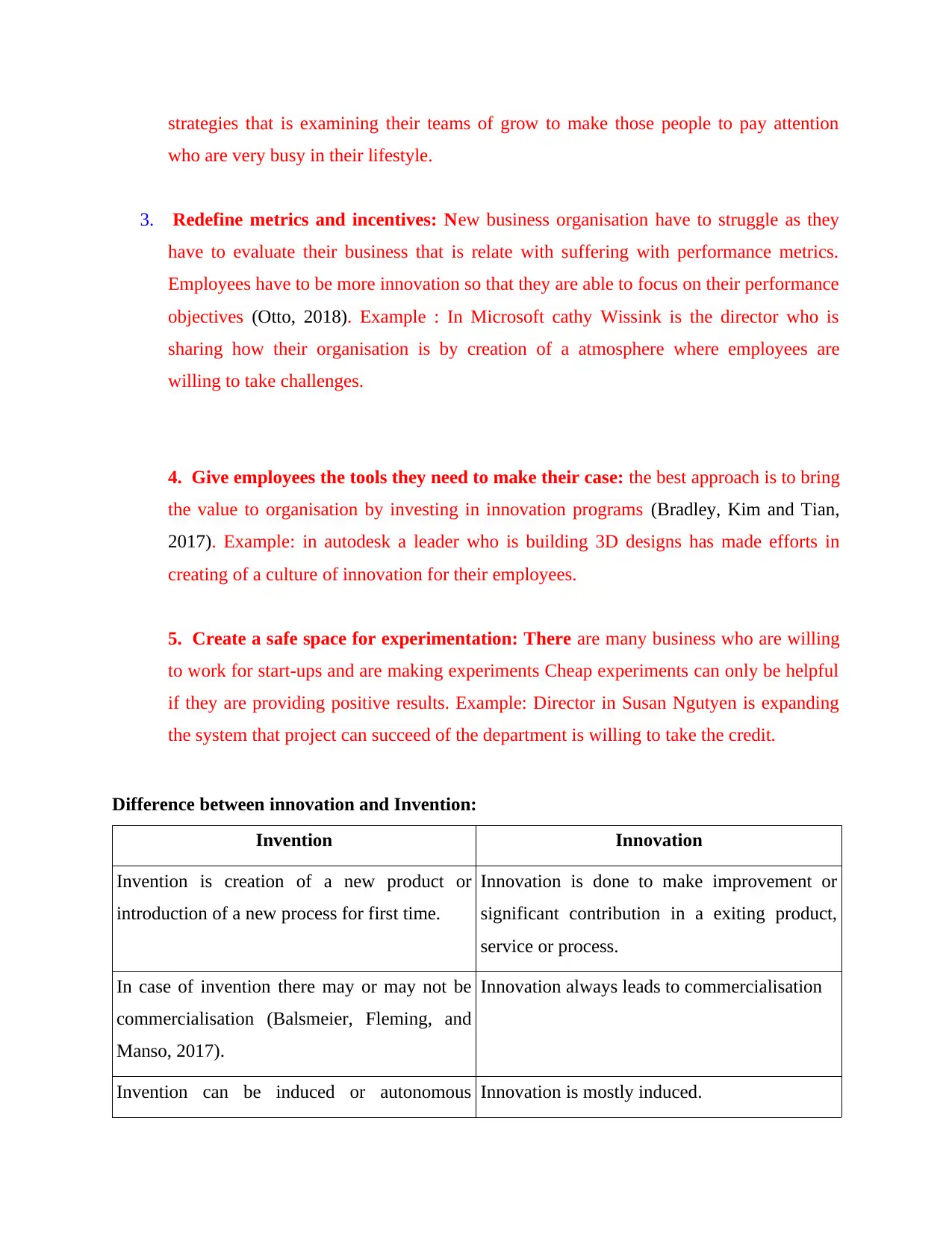
strategies that is examining their teams of grow to make those people to pay attention
who are very busy in their lifestyle.
3. Redefine metrics and incentives: New business organisation have to struggle as they
have to evaluate their business that is relate with suffering with performance metrics.
Employees have to be more innovation so that they are able to focus on their performance
objectives (Otto, 2018). Example : In Microsoft cathy Wissink is the director who is
sharing how their organisation is by creation of a atmosphere where employees are
willing to take challenges.
4. Give employees the tools they need to make their case: the best approach is to bring
the value to organisation by investing in innovation programs (Bradley, Kim and Tian,
2017). Example: in autodesk a leader who is building 3D designs has made efforts in
creating of a culture of innovation for their employees.
5. Create a safe space for experimentation: There are many business who are willing
to work for start-ups and are making experiments Cheap experiments can only be helpful
if they are providing positive results. Example: Director in Susan Ngutyen is expanding
the system that project can succeed of the department is willing to take the credit.
Difference between innovation and Invention:
Invention Innovation
Invention is creation of a new product or
introduction of a new process for first time.
Innovation is done to make improvement or
significant contribution in a exiting product,
service or process.
In case of invention there may or may not be
commercialisation (Balsmeier, Fleming, and
Manso, 2017).
Innovation always leads to commercialisation
Invention can be induced or autonomous Innovation is mostly induced.
who are very busy in their lifestyle.
3. Redefine metrics and incentives: New business organisation have to struggle as they
have to evaluate their business that is relate with suffering with performance metrics.
Employees have to be more innovation so that they are able to focus on their performance
objectives (Otto, 2018). Example : In Microsoft cathy Wissink is the director who is
sharing how their organisation is by creation of a atmosphere where employees are
willing to take challenges.
4. Give employees the tools they need to make their case: the best approach is to bring
the value to organisation by investing in innovation programs (Bradley, Kim and Tian,
2017). Example: in autodesk a leader who is building 3D designs has made efforts in
creating of a culture of innovation for their employees.
5. Create a safe space for experimentation: There are many business who are willing
to work for start-ups and are making experiments Cheap experiments can only be helpful
if they are providing positive results. Example: Director in Susan Ngutyen is expanding
the system that project can succeed of the department is willing to take the credit.
Difference between innovation and Invention:
Invention Innovation
Invention is creation of a new product or
introduction of a new process for first time.
Innovation is done to make improvement or
significant contribution in a exiting product,
service or process.
In case of invention there may or may not be
commercialisation (Balsmeier, Fleming, and
Manso, 2017).
Innovation always leads to commercialisation
Invention can be induced or autonomous Innovation is mostly induced.
⊘ This is a preview!⊘
Do you want full access?
Subscribe today to unlock all pages.

Trusted by 1+ million students worldwide
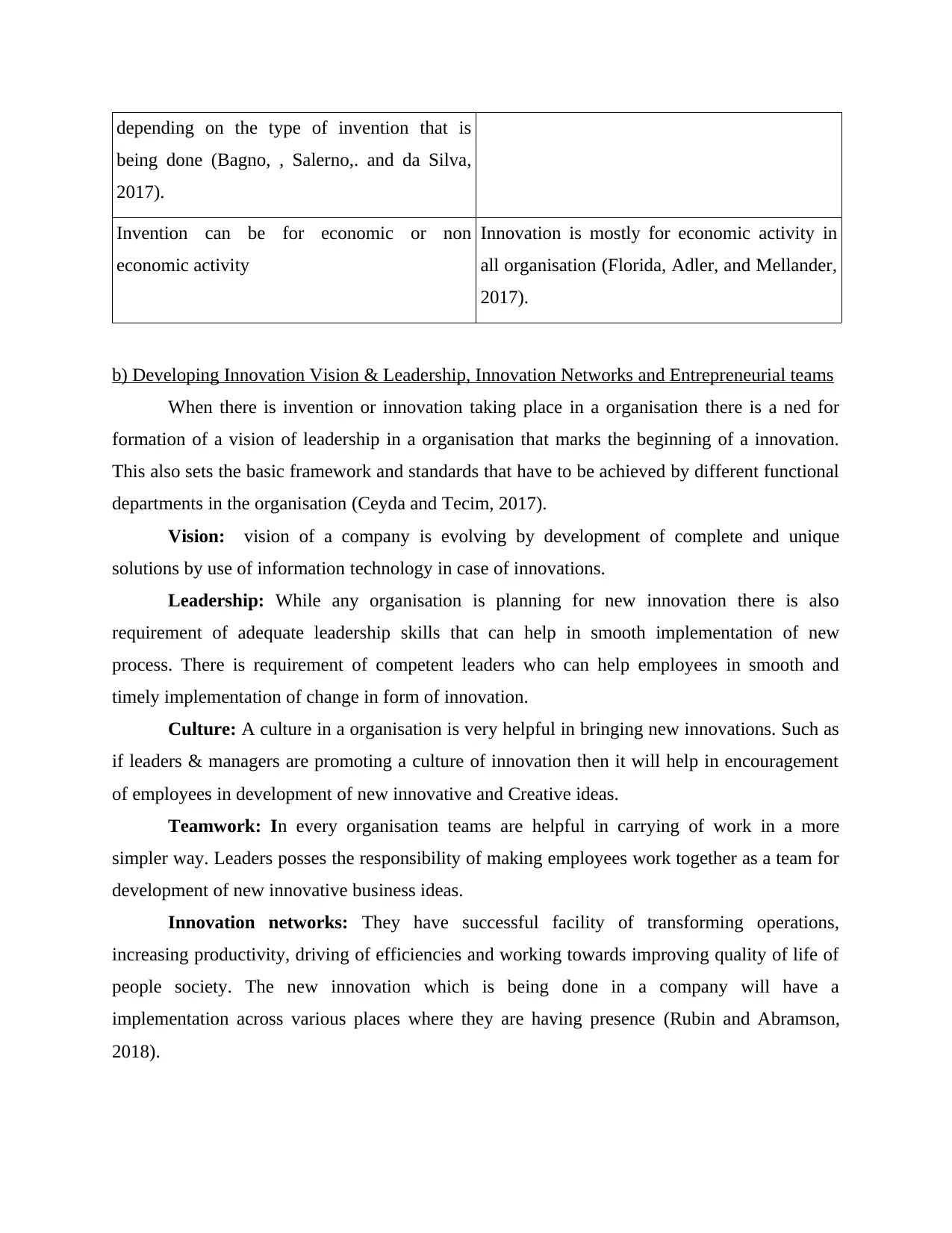
depending on the type of invention that is
being done (Bagno, , Salerno,. and da Silva,
2017).
Invention can be for economic or non
economic activity
Innovation is mostly for economic activity in
all organisation (Florida, Adler, and Mellander,
2017).
b) Developing Innovation Vision & Leadership, Innovation Networks and Entrepreneurial teams
When there is invention or innovation taking place in a organisation there is a ned for
formation of a vision of leadership in a organisation that marks the beginning of a innovation.
This also sets the basic framework and standards that have to be achieved by different functional
departments in the organisation (Ceyda and Tecim, 2017).
Vision: vision of a company is evolving by development of complete and unique
solutions by use of information technology in case of innovations.
Leadership: While any organisation is planning for new innovation there is also
requirement of adequate leadership skills that can help in smooth implementation of new
process. There is requirement of competent leaders who can help employees in smooth and
timely implementation of change in form of innovation.
Culture: A culture in a organisation is very helpful in bringing new innovations. Such as
if leaders & managers are promoting a culture of innovation then it will help in encouragement
of employees in development of new innovative and Creative ideas.
Teamwork: In every organisation teams are helpful in carrying of work in a more
simpler way. Leaders posses the responsibility of making employees work together as a team for
development of new innovative business ideas.
Innovation networks: They have successful facility of transforming operations,
increasing productivity, driving of efficiencies and working towards improving quality of life of
people society. The new innovation which is being done in a company will have a
implementation across various places where they are having presence (Rubin and Abramson,
2018).
being done (Bagno, , Salerno,. and da Silva,
2017).
Invention can be for economic or non
economic activity
Innovation is mostly for economic activity in
all organisation (Florida, Adler, and Mellander,
2017).
b) Developing Innovation Vision & Leadership, Innovation Networks and Entrepreneurial teams
When there is invention or innovation taking place in a organisation there is a ned for
formation of a vision of leadership in a organisation that marks the beginning of a innovation.
This also sets the basic framework and standards that have to be achieved by different functional
departments in the organisation (Ceyda and Tecim, 2017).
Vision: vision of a company is evolving by development of complete and unique
solutions by use of information technology in case of innovations.
Leadership: While any organisation is planning for new innovation there is also
requirement of adequate leadership skills that can help in smooth implementation of new
process. There is requirement of competent leaders who can help employees in smooth and
timely implementation of change in form of innovation.
Culture: A culture in a organisation is very helpful in bringing new innovations. Such as
if leaders & managers are promoting a culture of innovation then it will help in encouragement
of employees in development of new innovative and Creative ideas.
Teamwork: In every organisation teams are helpful in carrying of work in a more
simpler way. Leaders posses the responsibility of making employees work together as a team for
development of new innovative business ideas.
Innovation networks: They have successful facility of transforming operations,
increasing productivity, driving of efficiencies and working towards improving quality of life of
people society. The new innovation which is being done in a company will have a
implementation across various places where they are having presence (Rubin and Abramson,
2018).
Paraphrase This Document
Need a fresh take? Get an instant paraphrase of this document with our AI Paraphraser
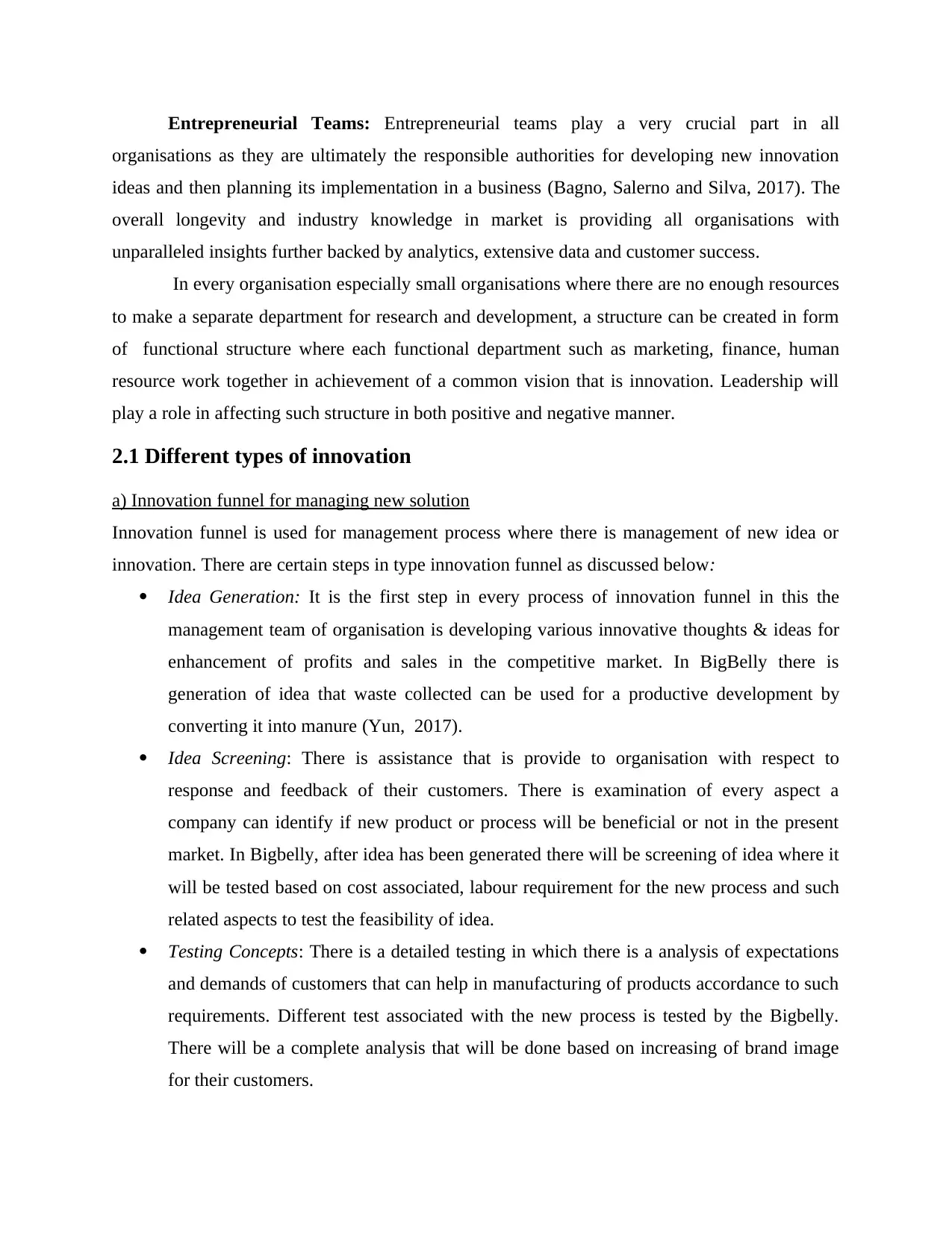
Entrepreneurial Teams: Entrepreneurial teams play a very crucial part in all
organisations as they are ultimately the responsible authorities for developing new innovation
ideas and then planning its implementation in a business (Bagno, Salerno and Silva, 2017). The
overall longevity and industry knowledge in market is providing all organisations with
unparalleled insights further backed by analytics, extensive data and customer success.
In every organisation especially small organisations where there are no enough resources
to make a separate department for research and development, a structure can be created in form
of functional structure where each functional department such as marketing, finance, human
resource work together in achievement of a common vision that is innovation. Leadership will
play a role in affecting such structure in both positive and negative manner.
2.1 Different types of innovation
a) Innovation funnel for managing new solution
Innovation funnel is used for management process where there is management of new idea or
innovation. There are certain steps in type innovation funnel as discussed below:
Idea Generation: It is the first step in every process of innovation funnel in this the
management team of organisation is developing various innovative thoughts & ideas for
enhancement of profits and sales in the competitive market. In BigBelly there is
generation of idea that waste collected can be used for a productive development by
converting it into manure (Yun, 2017).
Idea Screening: There is assistance that is provide to organisation with respect to
response and feedback of their customers. There is examination of every aspect a
company can identify if new product or process will be beneficial or not in the present
market. In Bigbelly, after idea has been generated there will be screening of idea where it
will be tested based on cost associated, labour requirement for the new process and such
related aspects to test the feasibility of idea.
Testing Concepts: There is a detailed testing in which there is a analysis of expectations
and demands of customers that can help in manufacturing of products accordance to such
requirements. Different test associated with the new process is tested by the Bigbelly.
There will be a complete analysis that will be done based on increasing of brand image
for their customers.
organisations as they are ultimately the responsible authorities for developing new innovation
ideas and then planning its implementation in a business (Bagno, Salerno and Silva, 2017). The
overall longevity and industry knowledge in market is providing all organisations with
unparalleled insights further backed by analytics, extensive data and customer success.
In every organisation especially small organisations where there are no enough resources
to make a separate department for research and development, a structure can be created in form
of functional structure where each functional department such as marketing, finance, human
resource work together in achievement of a common vision that is innovation. Leadership will
play a role in affecting such structure in both positive and negative manner.
2.1 Different types of innovation
a) Innovation funnel for managing new solution
Innovation funnel is used for management process where there is management of new idea or
innovation. There are certain steps in type innovation funnel as discussed below:
Idea Generation: It is the first step in every process of innovation funnel in this the
management team of organisation is developing various innovative thoughts & ideas for
enhancement of profits and sales in the competitive market. In BigBelly there is
generation of idea that waste collected can be used for a productive development by
converting it into manure (Yun, 2017).
Idea Screening: There is assistance that is provide to organisation with respect to
response and feedback of their customers. There is examination of every aspect a
company can identify if new product or process will be beneficial or not in the present
market. In Bigbelly, after idea has been generated there will be screening of idea where it
will be tested based on cost associated, labour requirement for the new process and such
related aspects to test the feasibility of idea.
Testing Concepts: There is a detailed testing in which there is a analysis of expectations
and demands of customers that can help in manufacturing of products accordance to such
requirements. Different test associated with the new process is tested by the Bigbelly.
There will be a complete analysis that will be done based on increasing of brand image
for their customers.
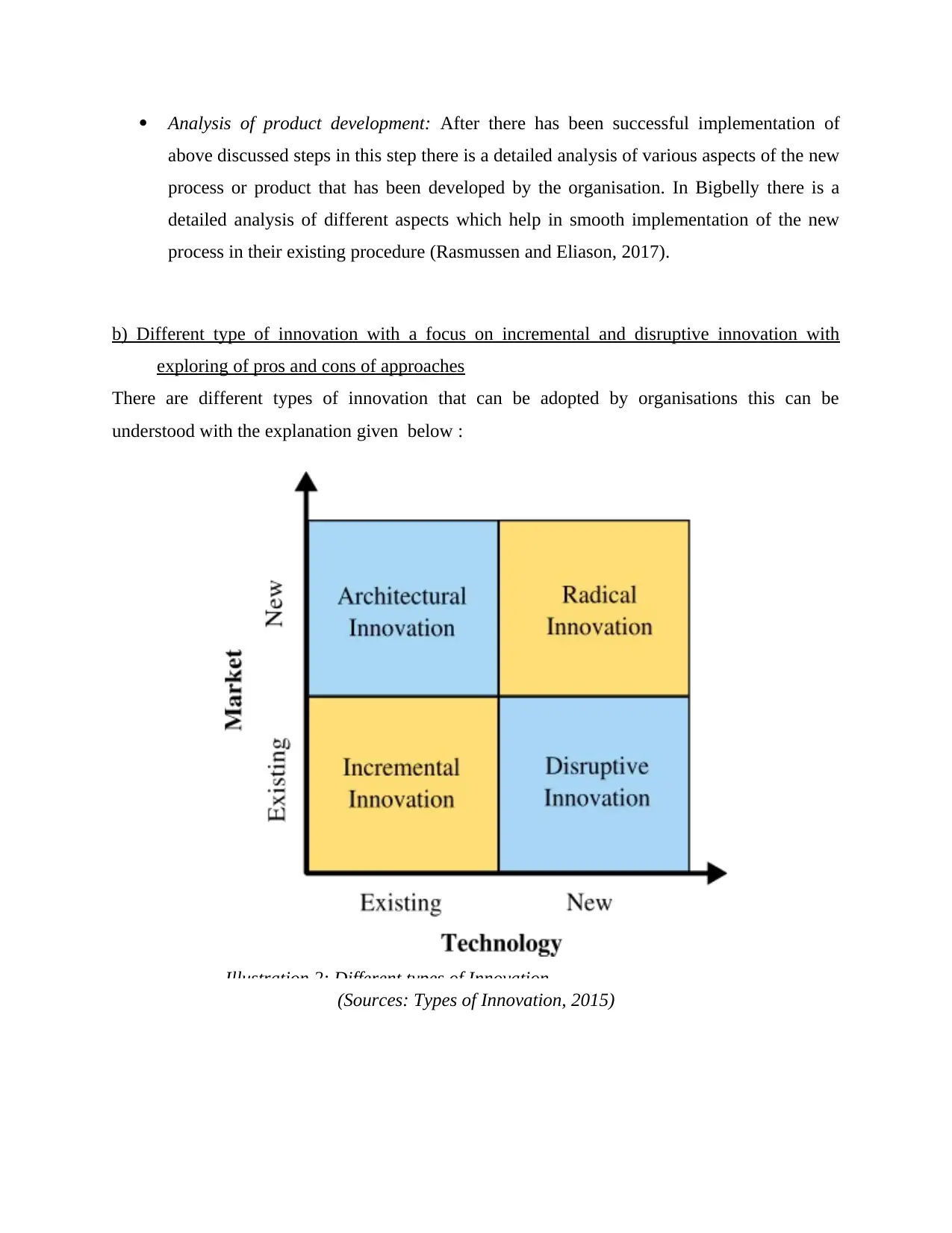
Analysis of product development: After there has been successful implementation of
above discussed steps in this step there is a detailed analysis of various aspects of the new
process or product that has been developed by the organisation. In Bigbelly there is a
detailed analysis of different aspects which help in smooth implementation of the new
process in their existing procedure (Rasmussen and Eliason, 2017).
b) Different type of innovation with a focus on incremental and disruptive innovation with
exploring of pros and cons of approaches
There are different types of innovation that can be adopted by organisations this can be
understood with the explanation given below :
(Sources: Types of Innovation, 2015)
Illustration 2: Different types of Innovation
above discussed steps in this step there is a detailed analysis of various aspects of the new
process or product that has been developed by the organisation. In Bigbelly there is a
detailed analysis of different aspects which help in smooth implementation of the new
process in their existing procedure (Rasmussen and Eliason, 2017).
b) Different type of innovation with a focus on incremental and disruptive innovation with
exploring of pros and cons of approaches
There are different types of innovation that can be adopted by organisations this can be
understood with the explanation given below :
(Sources: Types of Innovation, 2015)
Illustration 2: Different types of Innovation
⊘ This is a preview!⊘
Do you want full access?
Subscribe today to unlock all pages.

Trusted by 1+ million students worldwide
1 out of 25
Related Documents
Your All-in-One AI-Powered Toolkit for Academic Success.
+13062052269
info@desklib.com
Available 24*7 on WhatsApp / Email
![[object Object]](/_next/static/media/star-bottom.7253800d.svg)
Unlock your academic potential
Copyright © 2020–2025 A2Z Services. All Rights Reserved. Developed and managed by ZUCOL.





